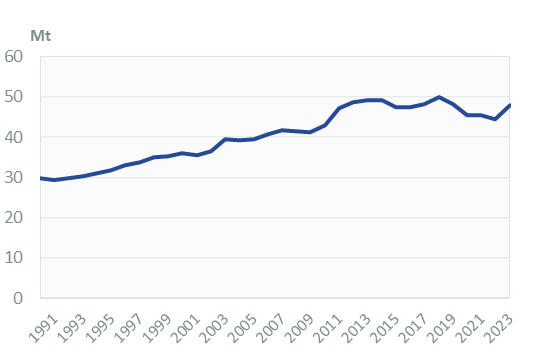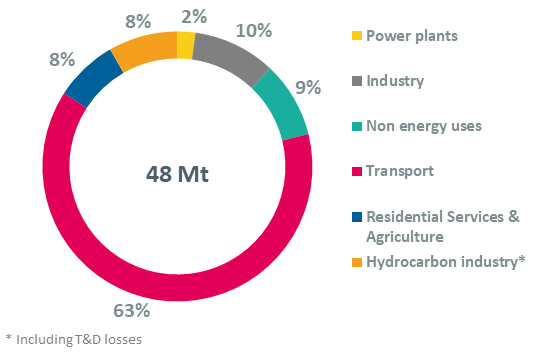-
-
 Energy and Climate Databases
Energy and Climate Databases- The most comprehensive and up-to-date annual energy database.
- Monitoring of technology providers in H2 supply chain.
- Monthly energy data on key energy markets.
- The most reliable and up-to-date power generation database.
- The essentials of LNG trade at your fingertips.
- Global monitoring of new and existing refineries.
- Analyse energy consumption and efficiency trends at world level. Benchmark countries.
- Have your database developed by a recognised expert of both energy and IT.
-
 Energy - Climate Forecasts
Energy - Climate Forecasts- Instant access to energy and emissions forecasts.
- Strategic, annual wholesale price projections backed by Enerdata's energy modelling expertise and our globally recognised POLES model.
- Wedges module showing a breakdown of the levers enabling to reduce emissions between two scenarios.
- Unique, independent projections of consumption by end-use.
- GHG Marginal Abatement Cost Curves.
- Benefit from proven models to draw your own energy scenarios and anticipate tomorrow’s challenges.
-
 Market Intelligence
Market Intelligence- 110 Energy and climate country reports
- A newsletter to receive the latest updates on evolving technologies and policies.
- Global energy news and analyses curated daily.
- Enerdata’s experts bring you the essentials about your market and competitors.
-
-
-
 Market Analysis
Market Analysis- Understanding key consumption trends and drivers across sectors.
- Granular and exclusive insight to address the most pressing business and strategic issues.
- Expertise in strategic and business intelligence, with fine-tuning to the market’s specificities.
-
 Energy - Climate Scenarios
Energy - Climate Scenarios- Providing the outlook of an energy commodity in mid to long term time horizons.
- Sector and driver specific energy demand forecasting.
- Assess the evolution of energy prices on the international and regional markets, as well as end-users prices.
- Enerdata guides you through pathways to reach climate targets.
- Supporting local authorities in their decarbonisation strategies.
-
 Climate Strategy and Policy Evaluation
Climate Strategy and Policy Evaluation- Cutting-edge quantitative tools and relevant indicators to monitor and evaluate evolutions on worldwide energy markets.
- Analysis of the most cost-effective options to reduce emissions.
- Quantified simulation and analysis of pledges for climate change negotiations.
- Breakdown and analysis of carbon markets.
- Enerdata guides you on the most beneficial policy or investment options.
- Turning climate objectives into concrete action plans.
-
 Training
Training- Understand different policy targets and measures on energy efficiency.
- How to measure energy savings?
- Energy Forecasting is a 2 days training to learn to design and interpret energy forecasts.
- Energy statistics training allowing to create energy balance with supply, transformation and consumption and understanding the international energy statistics regulations.
- Initiation to EnerMED level 1is the training to approach on the most powerful energy demand forecasting model.
-
-
Resource Centre
Australia Key Figures
- Population:
- 26.3 million
- GDP growth rate:
- 2.06 %/year
- Energy independence:
- 100%
Data of the last year available: 2023
- Total consumption/GDP:*
- 74.6 (2005=100)
- CO2 Emissions:
- 13.6 tCO2/capita
- Rate of T&D power losses:
- 5.11%
* at purchasing power parity
View all macro and energy indicators in the Australia energy report
Australia Related News
View all news, archive your new and create your own daily newsletters only on your topics/countries of interest with Key Energy Intelligence
Australia Related Research
Benefit from up to 2 000 up-to-date data series for 186 countries in Global Energy & CO2 data
A data overview is available in the global energy statistics app
Total Energy Consumption
Per capita energy consumption is around 25% higher than the average of OECD countries, amounting to 5.0 toe/cap in 2023, while per capita electricity consumption was 9.3 MWh/cap.
Total energy consumption remained relatively stable between 2010 and 2023 (between 130 and 135 Mtoe according to the year considered).
Interactive Chart Australia Total Energy Consumption
Benefit from up to 2 000 up-to-date data series for 186 countries in Global Energy & CO2 data
View the detailed fondamentals of the market at country level (graphs, tables, analysis) in the Australia energy report
Crude Oil Production
Australia's production of liquid hydrocarbons (crude oil, condensates, and NGLs) dropped by 13% in 2023 to reach 15.8 Mt. It increased by 40% between 2018 and 2020, reaching 20 Mt and declined slightly until 2022.
Oil production halved between its peak at 32 Mt in 2000 and 2023, due to the decline in production from mature basins. The production is mostly due to its two largest producing basins, the Browse and Carnarvon basins in north-western Australia.
Interactive Chart Australia Crude Oil Production
Benefit from up to 2 000 up-to-date data series for 186 countries in Global Energy & CO2 data
Additionally, for more detailed information on refineries, you can request a sample of our Asia Refineries Dataset
Oil Products Consumption
The consumption of oil products has fluctuated in a range between 44 and 48 Mtoe since 2011.
The transport sector accounts for 63% of oil consumption, followed by industry (10%), non-energy uses (9%) and the hydrocarbon sector (8%).
Graph: OIL CONSUMPTION (Mt)

Graph: OIL CONSUMPTION BREAKDOWN BY SECTOR (2023, %)

Interactive Chart Australia Refined Oil Products Production
Benefit from up to 2 000 up-to-date data series for 186 countries in Global Energy & CO2 data
Additionally, for more detailed information on refineries, you can request a sample of our Asia Refineries Dataset
Natural Gas Consumption
Natural gas consumption increased very rapidly between 2006 and 2020 (3.4%/year on average) before stabilising around 45 bcm since 2020. This increase was mainly driven by the development of gas-fired power capacity and the explosion of the LNG sector.
The industry accounts for 36% of consumption, electricity production for 29%, hydrocarbon sector for 21% and buildings and agriculture for 14%.
Graph: NATURAL GAS CONSUMPTION (bcm)

Interactive Chart Australia Natural Gas Domestic Consumption
Benefit from up to 2 000 up-to-date data series for 186 countries in Global Energy & CO2 data
Additionally, for more detailed information on the LNG trade, you can request a sample of our Asia LNG Trade Dataset
Coal Consumption
Coal and lignite consumption has declined by 35% since its peak in 2009, reaching 92 Mt in 2023. Most of the consumption goes to power generation (91%) and the remainder to industry.
Graph: COAL CONSUMPTION (Mt)

Graph: COAL CONSUMPTION BREAKDOWN BY SECTOR (2023, %)

Interactive Chart Australia Coal and Lignite Domestic Consumption
Benefit from up to 2 000 up-to-date data series for 186 countries in Global Energy & CO2 data
View the detailed consumption trends at country level (graphs, tables, analysis) in the Australia energy report
Power Consumption
Electricity consumption increased steadily between 2015 and 2022, by 0.5%/year on average, reaching 245 TWh in 2023. This increase is mainly driven by the residential sector.
Industry is the largest user of electricity with 32% of the consumption, followed by households (28%), services (27%), and the energy sector hydrocarbon and coal mining and processing ("others").
Graph: ELECTRICITY CONSUMPTION (TWh)

CO2 Fuel Combustion/CO2 Emissions
In 2022, Australia raised its 2030 carbon emission reduction target to 43% by 2030 (from 2005 levels), up from the previous target of between 26% and 28% set in its updated NDC.
GHG emissions have decreased by 25% since 2005, from 621 MtCO2eq to 467 MtCO2eq in 2023 (Fiscal Year ending in June), with the goal of 354 MtCO2eq in 2030.
The government committed to reaching net-zero emissions by 2050 in its Long-Term Strategy (2021), which was approved by the Australian Senate in September 2022. Several Australian states have set more ambitious targets: